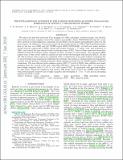Files in this item
The extraordinary outburst in the massive protostellar system NGC6334I-MM1 : emergence of strong 6.7 GHz methanol masers
Item metadata
| dc.contributor.author | Hunter, T. R. | |
| dc.contributor.author | Brogan, C. L. | |
| dc.contributor.author | MacLeod, G. C. | |
| dc.contributor.author | Cyganowski, C. J. | |
| dc.contributor.author | Chibueze, J. O. | |
| dc.contributor.author | Friesen, R. | |
| dc.contributor.author | Hirota, T. | |
| dc.contributor.author | Smits, D. P. | |
| dc.contributor.author | Chandler, C. J. | |
| dc.contributor.author | Indebetouw, R. | |
| dc.date.accessioned | 2018-02-05T17:30:06Z | |
| dc.date.available | 2018-02-05T17:30:06Z | |
| dc.date.issued | 2018-02-23 | |
| dc.identifier | 252179651 | |
| dc.identifier | 871f2724-1bb4-43d2-9c51-29f21f17097b | |
| dc.identifier | 85042706849 | |
| dc.identifier | 000425961400007 | |
| dc.identifier.citation | Hunter , T R , Brogan , C L , MacLeod , G C , Cyganowski , C J , Chibueze , J O , Friesen , R , Hirota , T , Smits , D P , Chandler , C J & Indebetouw , R 2018 , ' The extraordinary outburst in the massive protostellar system NGC6334I-MM1 : emergence of strong 6.7 GHz methanol masers ' , Astrophysical Journal , vol. 854 , no. 2 , 170 . https://doi.org/10.3847/1538-4357/aaa962 | en |
| dc.identifier.issn | 0004-637X | |
| dc.identifier.other | ArXiv: http://arxiv.org/abs/1801.02141v1 | |
| dc.identifier.uri | https://hdl.handle.net/10023/12671 | |
| dc.description | C. J. Cyganowski acknowledges support from the STFC (grant number ST/M001296/1). | en |
| dc.description.abstract | We report the first sub-arcsecond VLA imaging of 6 GHz continuum, methanol maser, and excited-state hydroxyl maser emission toward the massive protostellar cluster NGC6334I following the recent 2015 outburst in (sub)millimeter continuum toward MM1, the strongest (sub)millimeter source in the protocluster. In addition to detections toward the previously known 6.7 GHz Class II methanol maser sites in the hot core MM2 and the UCHII region MM3 (NGC6334F), we find new maser features toward several components of MM1, along with weaker features ∼1” north, west, and southwest of MM1, and toward the non-thermal radio continuum source CM2. None of these areas have heretofore exhibited Class II methanol maser emission in three decades of observations. The strongest MM1 masers trace a dust cavity, while no masers are seen toward the strongest dust sources MM1A, 1B and 1D. The locations of the masers are consistent with a combination of increased radiative pumping due to elevated dust grain temperature following the outburst, the presence of infrared photon propagation cavities, and the presence of high methanol column densities as indicated by ALMA images of thermal transitions. The non-thermal radio emission source CM2 (2” north of MM1) also exhibits new maser emission from the excited 6.035 and 6.030 GHz OH lines. Using the Zeeman effect, we measure a line-of-sight magnetic field of +0.5 to +3.7 mG toward CM2. In agreement with previous studies, we also detect numerous methanol and excited OH maser spots toward the UCHII region MM3, with predominantly negative line-of-sight magnetic field strengths of -2 to -5 mG and an intriguing south-north field reversal. | |
| dc.format.extent | 993408 | |
| dc.language.iso | eng | |
| dc.relation.ispartof | Astrophysical Journal | en |
| dc.subject | Stars: formation | en |
| dc.subject | Stars: protostars | en |
| dc.subject | ISM: individual objects (NGC6334I) | en |
| dc.subject | Radio continuum: ISM | en |
| dc.subject | ISM: magnetic fields | en |
| dc.subject | QB Astronomy | en |
| dc.subject | QC Physics | en |
| dc.subject | Astronomy and Astrophysics | en |
| dc.subject | DAS | en |
| dc.subject.lcc | QB | en |
| dc.subject.lcc | QC | en |
| dc.title | The extraordinary outburst in the massive protostellar system NGC6334I-MM1 : emergence of strong 6.7 GHz methanol masers | en |
| dc.type | Journal article | en |
| dc.contributor.sponsor | Science & Technology Facilities Council | en |
| dc.contributor.institution | University of St Andrews. School of Physics and Astronomy | en |
| dc.identifier.doi | https://doi.org/10.3847/1538-4357/aaa962 | |
| dc.description.status | Peer reviewed | en |
| dc.identifier.grantnumber | ST/M001296/1 | en |
This item appears in the following Collection(s)
Items in the St Andrews Research Repository are protected by copyright, with all rights reserved, unless otherwise indicated.

